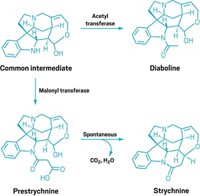Advertisement
Grab your lab coat. Let's get started
Welcome!
Welcome!
Create an account below to get 6 C&EN articles per month, receive newsletters and more - all free.
It seems this is your first time logging in online. Please enter the following information to continue.
As an ACS member you automatically get access to this site. All we need is few more details to create your reading experience.
Not you? Sign in with a different account.
Not you? Sign in with a different account.
ERROR 1
ERROR 1
ERROR 2
ERROR 2
ERROR 2
ERROR 2
ERROR 2
Password and Confirm password must match.
If you have an ACS member number, please enter it here so we can link this account to your membership. (optional)
ERROR 2
ACS values your privacy. By submitting your information, you are gaining access to C&EN and subscribing to our weekly newsletter. We use the information you provide to make your reading experience better, and we will never sell your data to third party members.
Biological Chemistry
How Cells Achieve Omnipotence
Developmental Biology: Researchers discover the potential mechanism by which a newly formed zygote turns into an embryonic stem cell
August 15, 2011
In the first moments after a sperm fertilizes an egg, cytosine bases on the newly combined DNA are rapidly demethylated to create an all-powerful embryonic stem cell, but exactly how this occurs has long kept scientists guessing. Now researchers led by Guo-Liang Xu, a biochemist at the Chinese Academy of Sciences in Shanghai, have finally pinpointed enzymes that can coordinate this elusive process, known as “active demethylation” (Science, DOI: 10.1126/science.1210944).
“People have been searching for the mechanism of active demethylation for decades,” says Chuan He, a chemist at the University of Chicago and a member of the research team. The results provide the first detailed biochemical blueprint for one of biology’s most important processes, the origin of life, He says.
According to the new research, a methylated cytosine—which silences transcription of genes containing the mark—is demethylated by several enzymes. First, a family of enzymes called Tet oxidizes 5-methylcytosine to 5-hydroxymethylcytosine and then to 5-carboxylcytosine. Next, a glycosylase enzyme called TDG removes the 5-carboxylcytosine from the double-stranded DNA. Loss of the base activates DNA repair enzymes to insert a cytosine base at the same spot on the DNA. This new proposed pathway does not proceed via a deamination step, which was included in earlier models, He says.
“This research provides the most direct biochemical evidence to date of active demethylation—they’ve found enzymes capable of executing their proposed pathway,” comments Suneet Agarwal, a stem cell biologist at Harvard Medical School. However, to conclusively prove that the proposed pathway is the elusive active demethylation mechanism, he says, it must be shown to be active in a newly formed zygote, as opposed to the human kidney embryonic stem cells used in the research. This is in fact what Xu says he’s working on.




Join the conversation
Contact the reporter
Submit a Letter to the Editor for publication
Engage with us on Twitter